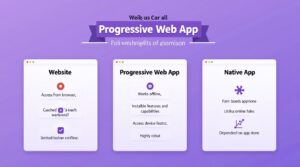click to get service View profile
The education technology landscape is evolving faster than ever, and Education App Design in 2025 is set to transform the way students, teachers, and institutions connect with digital learning platforms. With advancements in AI, personalized learning, immersive experiences, and intuitive interfaces, building an education app now demands far more than basic functionality. To truly stand out, it’s essential to adopt the latest design trends and proven best practices that drive usability, boost engagement, and ensure long-term retention.
In this guide, we’ll dive into Education App Design in 2025, covering the top 11 trends and best practices that will shape future-ready learning experiences. Whether you’re a designer, developer, or EdTech startup founder, these insights will help you create an app that not only looks modern but also delivers meaningful value to learners.
Top 11 Education App Design Trends in 2025
Here are the top 11 trends in education app UI/UX design that are trending.
1. AI-Powered Personalization
AI is playing a transformative role in Education App Design in 2025 by personalizing learning experiences through tailored paths, smart notifications, and adaptive challenges based on user behavior and performance. From dynamic dashboards to customized quizzes and content recommendations, AI helps bridge knowledge gaps and reduce learner stress by leveraging past behavioral data.
Recommends related content, videos, and questionnaires, helping students progress comfortably and reduce stress. This is essential when building a student learning app design that adapts to the user.
Need Help Designing Your Learning App?
Want to build an engaging, scalable, and learner-first app?
Let our UI/UX experts help you design your next education app
2. AI Chat Tutors and Voice Interface
Chat-enabled AI tutors, for instance, ChatGPT, now power real-time Q&A, feedback, and guidance to correct resources. Here, conversational interface matters the most.
Designing a chat-based layout with readable text bubbles, timestamps, profile icons; displaying proper informational hierarchy, like answers, images, and links to resources, and handling error messages with more suggestions, etc., is key in eLearning UX trends.
3. Minimalist, Simplified UI
A clean and clutter-free user interface is at the core of Education App Design in 2025. The minimalist approach emphasizes only what’s essential, avoiding unnecessary text, heavy animations, shadows, or complicated menus. This ensures an effortless experience for learners of all age groups and supports smooth access to educational content. In 2025, less is more—simplicity remains the guiding principle for structuring any modern education web app design project.
4. Gamification and Learning Rewards
Gamified design brings fun to education. The gamification elements in the learning app website design are extremely popular. Gamification is all about tweaking interaction and presenting boring content in interesting ways.
The result is better engagement, higher motivation to keep learning, and improved dwell time. In Education App Design in 2025, features like progress tracking bars, performance tables, or learning streaks spark curiosity and create a sense of urgency for students to improve in areas where they fall behind. This kind of interface encourages continuous growth and makes leveling up an integral part of the learning journey—making it a must-have feature in any modern education app.
5. Scroll-Learning UI: A New E-learning App UI Design
In Education App Design in 2025, a TikTok-inspired interface with scrollable card-based UIs transforms how students engage with content. Bite-sized videos, micro-lessons, and interactive quizzes appear as learners swipe, making education more accessible, easier to consume, and highly engaging. This modern approach turns lessons into interactive, digestible experiences that keep students motivated and curious to learn more.
The rhythmic visual flow, like text, images, videos, quizzes, and interactive elements, maintains interest and reduces monotony. This type of e-learning app UI design is highly effective for improving retention.
6. Dark Mode and Accessibility
Inclusive design is standard, not optional. Accessibility features like high-contrast UI, dark modes, text-to-speech, and adjustable font sizes ensure inclusive designs for diverse learners.
This must be implemented in any mobile learning app UI, especially when working with Figma education app templates.
7. Interactive Video Learning
Interactive videos are a powerful element of Education App Design in 2025, making learning more engaging with features like pop-up questions, clickable definitions, and choices that personalize the learning journey. From an HCI (Human-Computer Interaction) perspective, the design emphasizes user-friendliness through clear instructions, instant feedback, consistent interactions, playback control, and accessibility options such as captions.
These video layers should be considered essential in any modern education app design ideas workflow.
8. Gesture-Based Navigation
Swipe, tap, pinch—say goodbye to clunky menus and hello to smooth moves! Mastering these smooth gestures makes navigating your app feel as natural as scrolling through your favorite social media feed.
This approach works great in student learning apps or any EdTech UI design platform aiming for seamless flow.
9. Multi-Device Continuity
In Education App Design in 2025, students expect a seamless experience across all devices. Whether starting a lesson on a phone, continuing on a tablet, or completing an exam on a desktop, the interface should feel consistent and intuitive everywhere. Designing for this continuity ensures smooth transitions across platforms and creates a unified learning journey.
This is critical in education web app design projects for EdTech platforms.
10. 3D Visualization & Augmented Reality (AR)
AR-based learning is becoming a key part of Education App Design in 2025, especially for STEM subjects. Students can interact with 3D molecules, explore historical landmarks, or study biological models in immersive formats. When AR experiences are designed to be seamless and intuitive, they not only boost engagement but also deepen conceptual understanding.
Designers working on app designer education roles must master AR layouts.
11. Emotion-Driven Design
A smart approach to Education App Design in 2025 focuses on tapping into user emotions. By applying design principles such as color psychology, microinteractions, and subtle animations, apps can boost motivation, enhance engagement, and reduce learner anxiety, creating a more supportive and effective digital learning environment.
This leads to studying feeling more rewarding. Engaging transitions and gentle feedback create a supportive, feel-good learning environment where users stay curious and confident.
Best Examples of Education App Designs of 2025
Here are standout apps delivering cutting-edge EdTech UI design today:
1. Duolingo Max
- Offers GPT-powered AI conversation tutors
- Clean, colorful, gamified design
- Personalized skill trees and real-time correction
2. Coursera Mobile App
- Dark mode, offline feature support
- Adaptive content recommendations
- Integrated video discussions
3. Codecademy
- Modern, code-friendly interface with adaptive color schemes
- Interactive coding on the go, progress bars, and personalized dashboards
- Community features for sharing achievements, commenting, and peer discussions
4. Brainly
- Q&A community platform for collaborative problem-solving
- Clean, engaging interface for real-time question posting and expert/peer replies
- Points and a ranking system to drive interaction and learning
Education App Design Best Practices

To build a powerful, future-ready learning product in 2025, follow these design practices:
1. Prioritize Learner Goals Over Features
Design the app to move users closer to their learning outcomes, not overwhelm them with features.
2. Keep UI Intuitive and Clutter-Free
Think minimal and mobile-first. Use whitespace, large CTAs, and consistent navigation. Essential for scalable online learning app design.
3. Personalize Experiences Using Data
Use analytics to customize user journeys—course suggestions, difficulty levels, and reminders.
4. Gamify to Increase Engagement
Use progress bars, learning streaks, peer challenges, and tiered rewards aligned with learning goals.
5. Include Quality Accessibility Support
Design with WCAG standards, support screen readers, keyboard navigation, alt text for images, and color contrast.
Test User Flows with Real Students
Run usability tests with your target audience. Iterate the design based on actual feedback.
How to Make Your EdTech App Design Better

With nearly every EdTech company offering its own learning platform, standing out requires more than just basic functionality. In Education App Design in 2025, student retention becomes a critical factor for success. Focusing on strategies that enhance engagement and long-term use is essential to elevate your app design process and stay ahead of competitors.
1. Use Design Thinking for Feature Planning
Empathize, define, ideate, prototype, and test. Build with user problems at the core.
2. Adopt Atomic Design Systems
Use reusable design components and tokens. Tools like Figma and Sketch now support shared libraries for education app design Figma scalability.
3. Leverage AI for Rapid Prototyping
Use tools like Uizard AI, Framer AI, or Jasper to generate layouts, content ideas, or test interactions.
4. Align UX with Learning Outcomes
Design layouts that map learning tasks to tangible academic or cognitive progress.
5. Collaborate Across Functions
Involve educators, instructional designers, and cognitive science experts in the design loop.
Conclusion
Educational mobile apps in 2025 are becoming smarter, more dynamic, and increasingly learner-focused. Whether you’re launching a new EdTech startup or upgrading an existing platform, embracing the latest trends and best practices in Education App Design in 2025 is essential. This approach ensures the creation of apps that not only educate but also engage and empower users in today’s digital learning era.
In Education App Design in 2025, the user is no longer just a “learner” but a mobile-first, micro-content consumer seeking bite-sized, gamified, and personalized learning on the go. Whether you’re designing a mobile learning app UI, working with Figma education app templates, or developing a full learning platform, your design must align with this evolving learner behavior.
FAQs: Education App Design Trends and Best Practices
1. What are the most important education app design trends in 2025?
The most important trends include AI-powered personalization, gamification, gesture-based navigation, AR/3D learning, and scroll-learning interfaces.
2. How do I use Figma for education app design?
Using Figma education app templates, you can create reusable UI components, collaborate with teams, and build scalable, consistent mobile learning app UI systems.
3. What makes a good student learning app design?
It should be intuitive, goal-oriented, and personalized. Use features like streaks, interactive content, and minimalist UI to boost student engagement.
4. How can I improve accessibility in an online learning app design?
Follow WCAG guidelines, support screen readers, dark mode, adjustable fonts, and provide alt-text for all images.
5. What’s the benefit of gamification in education apps?
Gamification improves motivation, retention, and learning satisfaction through progress bars, levels, rewards, and peer challenges.
6. Is AR important in modern e-learning app UI design?
Yes, AR-based UI adds immersive learning experiences—perfect for STEM, history, and interactive training modules.
7. Can I build an education app without coding?
Yes, tools like Uizard AI, Framer AI, and Figma allow you to create a learning app prototype without any code, speeding up the design process.

